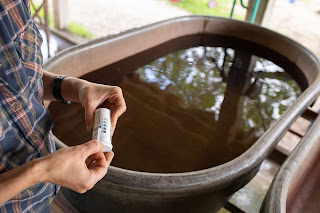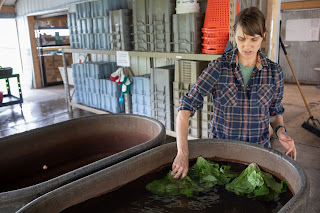Annalisa Hultberg Extension Educator, food safety
While not all produce should be washed during postharvest handling, some items like greens need to be washed to remove soil or to hydrocool to remove field heat from product. There are two general ways to wash produce - in a bulk tank or tub, or on a spray table. Read more for tips to reduce risk and keep your produce safe, clean and high quality in storage this season when washing in a bulk tank.
What are the risks with bulk washing?
Bacteria such as Salmonella spp. and Escherichia coli O157:H7 may be present on produce, or tools, hands or other surfaces, and can spread via produce wash water. Postharvest water has been linked to several foodborne illness outbreaks, including the Listeria on cantaloupe outbreak and a recent outbreak of Salmonella in shelled peas in Wisconsin.
While bulk washing is required in some instances (greens for example, and often broccoli and some other commodities need to be soaked and rinsed for postharvest quality and cooling), it does come with risks. That is because water can spread even a small amount of contamination. Even a small amount of bird poop can spread to all the produce in a tank, for example via the water. It is important to take steps to reduce the potential for spreading contamination in your tanks when washing this summer.
Remember - not all produce should be washed! For more information on washing produce, see this website.
Greens are washed in a tank
Start with clean water
Use a wash water sanitizer when possible
Sanitizer in wash treatments (Sanidate 5.0 peroxyacetic acid based sanitizer or 5.5% sodium hypochlorite bleach) will improve shelf life of the greens over a plain water rinse and reduce the risk of spreading contamination. This is because the sanitizing agents inactivate bacteria, viruses, spores, fungi and other microorganisms that can lead to degradation of fresh produce in storage. While it is not required, it is a good idea and way to reduce risk. Sanitizer does not sanitize the produce, but rather the water itself to reduce the chances it will spread contamination.
Read below for instructions on using sanitizer in wash water. If you are looking for an organically approved sanitizer for postharvest wash water, many growers use Sanidate 5.0 from BioSafe systems. You can find it at Johnny's or order it from Arbico Organics. Sanidate 5.0 breaks down in the environment into oxygen, water and carbon dioxide. It can also be used for sanitizing food contact surfaces like tools and equipment. The name and number for the local rep from Biosafe, who is based in New London MN is Jessica Jacobsen, jjacobsen@biosafesystems.com, 320-212-3905.
How to wash produce in water using a sanitizer
Step 1. Remove soil and organic matter from produce before washing
Lightly brush produce with thick skins or rinds (melons, potatoes, carrots) or prewash in plain water (leafy greens). Organic matter, such as dirt and other debris, reacts with the sanitizer solution to lower its effective concentration. The more organic matter in a water and sanitizer solution, the less effective the sanitizer is (especially chlorine - based sanitizers).
Step 2. Measure and mix solution for rinsing
Add the amount of sanitizer as indicated by the label to reach the PPM for fresh fruits and vegetables.
Water should be at a cool temperature, but not cold. If it is too cold the sanitizer will not be effective; if it is too warm it may encourage the growth of some pathogens and disease. Check the label of the sanitizer for effective temperature range.
If using household chlorine, use only plain, unscented household bleach without added thickeners or fragrances.
Step 3. Rinse products in the water with the sanitizer
Be very gentle with leafy greens and other items. Let the water remove the dirt, not your hands. Do not immerse tomatoes.
Step 4. Rinse products in fresh water if indicated by the label
Read the label carefully. Some sanitizers require a freshwater rinse, others do not. Here is a website with more information on choosing a sanitizer.
Step 5. Change water frequently
Used wash water can be poured onto non-edible crops, grasses or shrubs if you don’t have a drain. Make sure to change the water when it becomes dirty and when a new crop is added. After dumping old water, refill the container with clean water, re-measure the sanitizer, and test for concentration.
Step 6. Monitor pH and sanitizer levels
To maintain levels that are appropriate for your sanitizer, use test strips or another method to verify the concentration after each addition of sanitizer.
Other sanitizers will vary - follow the instructions on the package. pH level should be maintained between 6.0 and 7.0 to provide for the greatest effectiveness.
Step 7. Document the sanitizer levels on a log sheet
Keep a log sheet with the date, time, and concentration levels near your washing station. You should check the sanitizer level in the water after each addition of sanitizer and document the level on the log sheet.
Other important tips:
Make sure you do not harvest product with any visible signs of animal feces. Keeping the poop out of the water is the most important thing you can do to keep your produce clean and healthy.
Even if you do not use a sanitizer, change water frequently. Change it between batches, and when it is dirty. Consider washing greens in a two or three bin system to ensure they are very clean. Change the water in the second or third bin frequently. The first bin can be used to remove the bulk of the soil, depending on if the product is particularly dirty.
.jpg)





Comments
Post a Comment